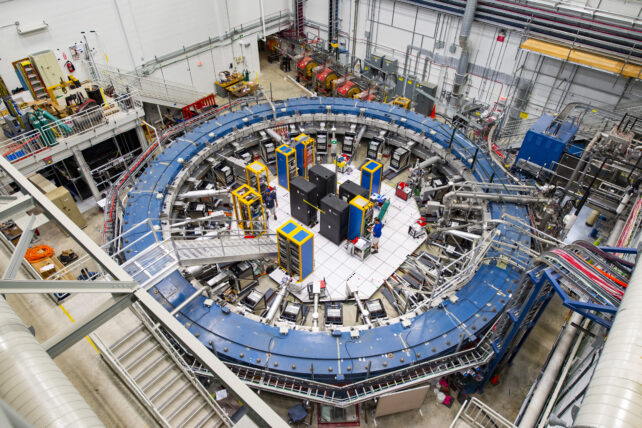Physicists at Fermilab have made the most precise measurement ever of a long-disputed value – the magnetic 'wiggle' of an elementary particle known as a muon.
In somewhat disappointing news, that measurement is in strong agreement with the Standard Model, meaning it probably isn't hiding any exotic new physics as some had hoped.
A muon is similar to an electron, except it's about 207 times more massive. The way muons move in a magnetic field should theoretically be very predictable, summed up in what's called its gyromagnetic ratio, or g.
In a simple world, the value of g should be a nice, neat 2 – but of course, that would be too easy. The muon's magnetic dance is something of an anomaly, and in the same way that pi is just a touch over 3, the muon's g-factor seemed to be very slightly over 2.
How slightly? Just 0.001165920705, according to new results from Fermilab's Muon g-2 experiment. This measurement incorporates data collected over six years of particle accelerator experiments.
The team says this final number is accurate to within 127 parts per billion. To put that level of precision into perspective, the researchers say if you measured the width of the US to that degree, you'd be able to tell if a single grain of sand was missing.

But the really intriguing part of the research is the room it left for new forces or particles to explain the anomalous magnetic motion.
A related project called the Muon g-2 Theory Initiative set out to check what the Standard Model predicted for this value. Incorporating a wider dataset than ever, their latest calculation comes out at 0.00116592033. That puts it extremely close to the value gained from experimental means, which leaves very little wiggle room for any cool, exotic physics to be at play.
"The anomalous magnetic moment, or g–2, of the muon is important because it provides a sensitive test of the Standard Model of particle physics," says Regina Rameika, experimental physicist at the US Department of Energy's Office of High Energy Physics.
"This is an exciting result and it is great to see an experiment come to a definitive end with a precision measurement."

As a muon spins inside a magnetic field, its poles should essentially line up with the field. That turned out to not be the case – instead, it wobbles ever so slightly, like an unbalanced spinning top. And if this wobble was particularly extreme, it could mean the muon is being nudged by unseen, unknown particles.
A vacuum isn't ever truly empty – thanks to quantum fluctuations, pairs of virtual particles are constantly popping into and out of existence. These brief interlopers to our reality can affect other nearby particles in various ways.
Thanks to its relative heft, the muon is particularly sensitive to the influence of virtual particles. So by precisely measuring how much the muon wobbles beyond its expected range, physicists could calculate the properties of these mysterious virtual particles, potentially unlocking a new realm of physics beyond the Standard Model. Hypothetical explanations could include dark photons or supersymmetry.
The g-factor of the muon has been a fascinating thorn in the side of physicists for decades. Clues that something was amiss came in 2001, when the first version of the Muon g-2 experiment revealed a wide discrepancy between theory and practice.
Further experiments over the decades since led to increasingly precise measurements, while techniques to calculate the predictions of the Standard Model also improved at the same time. And yet, a mismatch remained.
The current version of the Muon g-2 experiment was fired up in 2018, conducting a new run of experiments each year until 2023. Data from the first three runs were released in two batches, each seeming to point more and more towards new physics.

This latest measurement incorporates data from the full six runs, which more than triples the dataset used for the last release. That data isn't just more plentiful, but higher quality too, taking advantage of improvements made to the equipment.
Sadly for those hoping to add a few extra chapters to their physics textbooks, it seems that in this case everything is as it should be. That's not to say we know everything though – dark matter and even gravity don't fit into the Standard Model yet, so there's still plenty of holes left to plug.
The research has been submitted to the journal Physical Review Letters and is available on preprint server arXiv.
